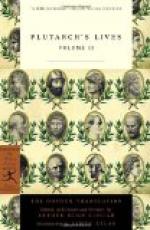[Footnote 63: See Penny Cyclopaedia, “Veins, Diseases of.” Cicero (Tusculan. Quaest. 2. c. 22) alludes to this story of the surgical operation. He uses the word Varices.]
[Footnote 64: Q. Caecilius Metellus was consul B.C. 109 with M. Junius Silanus. He obtained the Agnomen of Numidicus for his services in the Jugurthine war.]
[Footnote 65: Legatus is a participle from the verb Lego, which signifies to assign anything to a person to do; hence legatus is one to whom something is delegated. The Roman word Legatus had various senses. Here the word legatus, which is the word that Plutarch intends, is a superior officer who holds command under a Consul, Praetor, Proconsul, Propraetor.]
[Footnote 66: The story of Turpillius is told by Sallustius (Jugurthine War, 66), who speaks of his execution, but says nothing of his innocence being afterwards established. The Romans had in their armies a body of engineers called Fabri, and the director of the body was called Praefectus Fabrorum. Vaga, which Sallustius calls Vacoa, was one of the chief towns in Numidia.]
[Footnote 67: Sallustius, who tells the same story pretty nearly in the same way (Jugurth. War, c. 64), says that the son of Metellus was about twenty. The insult was not one to be forgiven by a man like Marius, to be told that it would be soon enough for him to be consul three-and-twenty years hence. This son is Q. Caecilius Metellus Pius who afterwards fought against Sertorius in Spain.]
[Footnote 68: The Latin word which Plutarch has translated is Imagines. These Imagines were busts of wax, marble, or metal, which the Romans of family placed in the entrance of their houses. They corresponded to a set of family portraits, but they were the portraits of men who had enjoyed the high offices of the State. These Imagines were carried in procession at funerals. Polybius (vi. 53) has a discourse on this subject, which is worth reading. Marius, who was a Novus Homo, a new man, had no family busts to show.]
[Footnote 69: Lucius Calpurnius Bestia was consul B.C. 111, and Spurius Postumius Albinus B.C. 110. They successively conducted the war against Jugurtha without success. Sallustius (Jugurth. War, c. 85) has put a long speech in the mouth of Marius on this occasion, which Plutarch appears to have used.]
[Footnote 70: Though much has been said on the subject, there is nothing worth adding to what Plutarch tells. He gives the various opinions that he had collected.]
[Footnote 71: This passage of the Celtic Galli into Italy is mentioned by Livius (5, c. 34) and referred by him to the reign of Tarquinius Priscus. This is the first invasion of Italy from the French side of the Alps that is recorded, and it has often been repeated.]
[Footnote 72: The modern Sea of Azoff.]
[Footnote 73: The Greek is [Greek: phuge], which hardly admits of explanation, though Coraes has explained it. I have followed Kaltwasser in adopting Reiske’s conjecture of [Greek: phule].]




